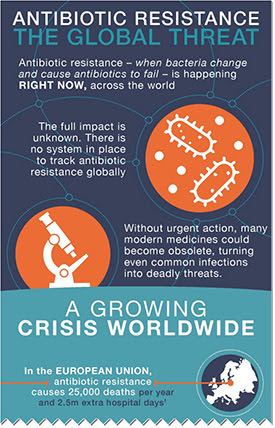Stop the Global Threat of Antimicrobial Resistance (AMR)
Support WHO World Antibiotics Week: November 16-22, 2015

Consider this: Alexander Fleming discovered the first antibiotic – penicillin – in 1928, at a time when the world’s population was less than 1/3 of what it is today and commercial air travel was not yet commonplace. In our century, dangerous bacteria can quickly spread from person to person across the globe. When these bacteria become resistant to the drugs we use against them, common infections can turn into deadly threats.
Rates of antimicrobial resistance (AMR) are rising around the world. Addressing this global threat is a key part of the worldwide commitment to the Global Health Security Agenda.
5 Things to Know
- Antibiotic-resistant bacteria are increasing all over the world, including the United States.
- The full impact of antibiotic resistance is unknown: there is currently no system in place to track antibiotic resistance globally.
- The global use of antibiotics by humans increased by more than 30 percent between 2000 and 2010.
- About 80 percent of antibiotic use takes place in the community. Unchecked use in outpatient and non-prescription settings is a major issue.
- The good news is that patients, providers, and policymakers can all take action to stop antibiotic resistance.
- Protecting the Power of Antibiotics: Lessons from Egypt
- The State of the World’s Antibiotics: Resistance Rates Rising, Stewardship is the Solution
- Antimicrobial Resistance – A Global Imperative
- Infographic: Antibiotic Resistance: The Global Threat
- Video: TED Talk – The Coming Crisis in Antibiotics
- CDC: Get Smart About Antibiotics
- CDC: Information on Drug Resistance
Don't Miss Reading
Below is a select bibliography of research conducted by CDC’s Division of Global Health Protection, which includes the Global Disease Detection program, in several of our program countries.
Bangladesh
Burden of typhoid and paratyphoid fever in a densely populated urban community, Dhaka, Bangladesh.
Burden of typhoid and paratyphoid fever in a densely populated urban community, Dhaka, Bangladesh.
Egypt
Patient Attitudes and Beliefs and Provider Practices Regarding Antibiotic Use for Acute Respiratory Tract Infections in Minya, Egypt.
Incidence and pathogen distribution of healthcare-associated infections in pilot hospitals in Egypt.
Patient Attitudes and Beliefs and Provider Practices Regarding Antibiotic Use for Acute Respiratory Tract Infections in Minya, Egypt.
Incidence and pathogen distribution of healthcare-associated infections in pilot hospitals in Egypt.


































No hay comentarios:
Publicar un comentario